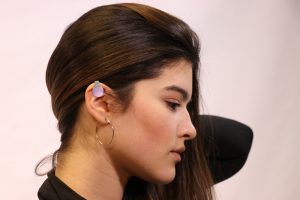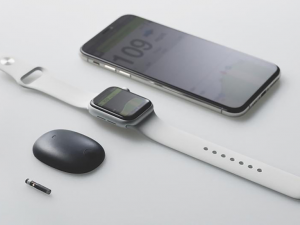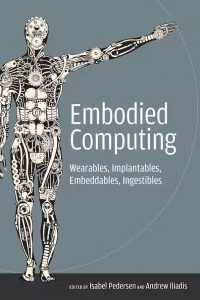The first wearable computing device was built to cheat. The next generation of wearables have more noble intent – but like that first device, dubbed by its developers as “The First Wearable Computer”, new wearable computers, biosensors and neural implants may also raise eyebrows.
MIT professors Claude Shannon and Edward Thorp engineered (they met back in the ‘60s) a small computing device that could calculate or anticipate results from a spin of a roulette wheel. Eventually, the Nevada state government clued into the ramifications of their invention and a law was passed banning wearable computers in casinos there. Much later, the two men released a paper which acknowledged their experiment (and winnings) while describing the small, battery-operated, rotor-manipulated device which was ‘worn’ on the foot.

OxiWear is an ear-wearable device for continuous oxygen monitoring; it can alert users about low oxygen levels in their body. As worn by athletes during competition, the pulse oximeter device (prototype shown) detects life threatening medical conditions, such as altitude sickness, high-altitude cerebral edema (brain swelling), and high-altitude pulmonary edema, all caused by low oxygen in body tissues.
The wearable computer market today is much more sophisticated, capable and ubiquitous: the number of consumers using wearables increased from nine per cent to 33 per cent in just four years, driven in no small part by developments in the health care and wellness sectors.
As with that first device, you can bet commercial, ethical and legal issues are sure to follow. New technological capabilities often come to market before a full understanding and evaluation of their impact.
From head to toe, wearables synced to smartphone apps can track data about users’ personal health and physical activity as well as important medical, physiological and psychological parameters. The data can be used to help identify health shortcomings or medical abnormalities and provide health and fitness recommendations. The health data can be shared with doctors, clinics and other healthcare providers for further consultation or treatment.
Wearables with motion sensing hardware and integrated accelerometers are widely used today. Chemical sensors are used to measure vital signs including heart rate, caloric burn and blood oxygen levels. Electrodes can measure nerve activity and autonomic response. New hardware sensors and software analytic tools can make important biomedical measurements non-invasively using light or other forms of radiation. (Wearable connected devices emit their own kinds of electromagnetic radiation and have been reported to cause headaches, dizziness or nausea for some users while wearing them.)

A continuous glucose monitoring implant for adults with diabetes that pairs with a mobile app to give instant blood sugar readings was first approved by the Food and Drug Administration in 2018. The system was created by Eversense. The tiny implantable sensor (far left) runs for up to six months.
Familiar wearable technology like today’s smartwatches and Fitbits are being joined by sensing devices that are not just worn but implanted or ingested! Blurring the lines between humans and computer still further, people can be hooked up to ‘body area networks’ that convey data from a bodily device to the Internet and back again.
Biosensors represent another type of wearable medical devices, different from wrist trackers and smartwatches; they can be small, self-adhesive digital patches that collects data on patient heart rate, respiration, and temperature.
Underneath all that sensing and tracking, artificial intelligence functionality is applied to make diagnostic sense of it all.
This expanding array of digital devices and computing capabilities that track our personal medical information and health status has led some Canadian academics and industry analysts to coin a new term, embodied computing, to describe both the sophisticated technologies being developed and the potentially thorny ethical, social and legal issues such technologies bring forth.
“Embodied technologies such as wearable tracking bracelets, ingestible sensors, embeddable prosthetics, and implantable microchips all stand to redefine the human experience and what it means to speak of technology and the body. No longer the speculative stuff of science fiction, embodied technologies have arrived and are being developed by a

Embodied Technology: Wearables, Implantables, Embeddables, Ingestibles, co-edited by Isabel Pedersen, Canada Research Chair in Digital Life, Media, and Culture and Associate Professor at the Ontario Tech University, and Andrew Iliadis, Assistant Professor in the Department of Media Studies and Production at Temple University.
variety of industries at an alarming rate,” describes the publisher of Embodied Technology: Wearables, Implantables, Embeddables, Ingestibles.
The book is co-edited by Isabel Pedersen, Canada Research Chair in Digital Life, Media, and Culture and Associate Professor at the Ontario Tech University, where she studies the cultural, ethical, and political challenges posed by technological change and emerging digital devices.
She’s also founding Director at the Digital Life Institute, based at Toronto Metropolitan University. It’s home to an international research network of multidisciplinary scholars studying the social implications of emergent digital technologies.
In her writings, lectures and public speaking engagements, Pedersen describes how immersive, embodied technology will change how we act, interact with others, participate in cultures, and understand our identities.
The book itself is filled with insightful contributor essays and articles looking at topics such as the policy implications of ingestibles; the invasive potential of body area networks that transmit data directly from bodily devices to the Internet; cyborg experiments to estabglish direct links between a human brain and a computer; the evolution of the ankle monitor and other intrusive electronic monitoring devices; fashiontech, which offers consumers an aura of “cool” in exchange for their data; and the “final frontier” of technosupremacism: technologies that seek to read our minds.
That’s before we place any bets.
-30-



